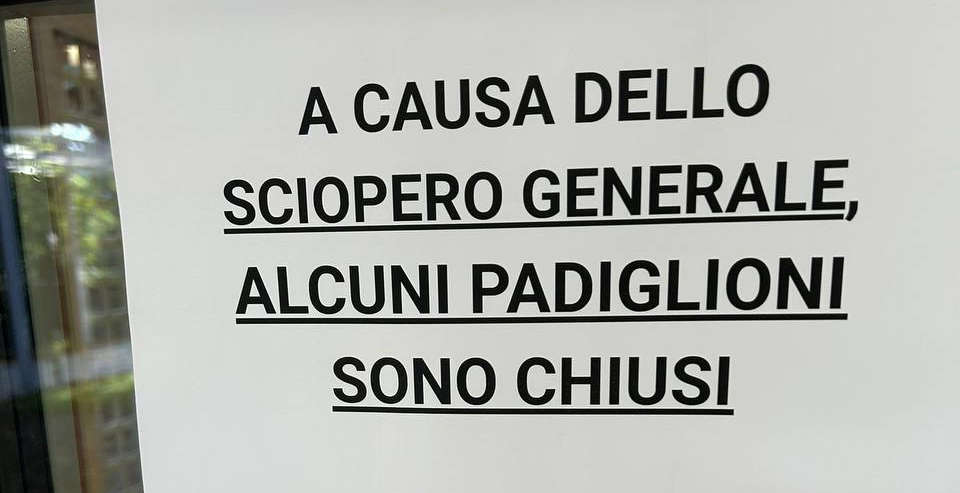The world of culture also came to a partial halt yesterday, Oct. 3, in a general strike called under the slogan “Let’s block everything for Gaza.” Many workers in the cultural sector joined the mobilization, leading to the partial closure of museums, libraries, theaters and archaeological sites across the country. From the Uffizi Galleries to the Venice Biennale, via public and private institutions, the strike’s adherence took on remarkable dimensions.
One of the symbolic centers of the protest was the Venice Biennale, where the 2025 edition of the Architecture Biennale is underway. At the Giardini venue, as many as thirteen pavilions remained closed: including those of Britain, Germany, Spain, Australia, Canada, Brazil and Switzerland, as well as the Rolex pavilion and one of the main entrances to the exhibition area. Even in the Arsenal, several pavilions did not open to the public, including those of Luxembourg, Morocco, Mexico, Saudi Arabia, Chile, and Singapore. Overall, more than 20 pavilions did not provide service, while ticket offices were manned by just four operators.
Many of the striking operators joined the procession that crossed the Ponte della Libertà bridge, a key junction between Venice and the mainland. The demonstration, which involved thousands of people, aimed to denounce the behavior of Italian institutions in the face of the ongoing conflict in Gaza and in particular in the face of the military operations conducted by Israel. An explicit and clear position, which also involved the world of art and culture, traditionally more cautious in exposing itself on current international political issues. Activists of the permanent assembly “Biennalocene” called the adhesion as a signal impossible to ignore by the Biennale’s management.




Adherence to the strike also had a significant impact in other Italian cities. Tallying up the number of institutions closed either completely or partially is the Mi Riconosci association, which released the list of sites today. In Florence, the Uffizi and Accademia Galleries were closed for a few hours, limiting opening to guaranteed hours. Also closed in Florence were the “Paolo Graziosi” Museum of Prehistory, the Oblate Library and the University Library of Architecture. In Bologna, the Musei Civici, the Pinacoteca Nazionale, the Archiginnasio Library, the University Library and the Teatro Comunale have suspended operations. In Venice, in addition to the Museum of Natural History, Ocean Space has also joined, while in Piedmont and Lombardy numerous civic libraries, including those in Monza, Bergamo, Brescia and Arese, have been affected by the closures.
Theaters also registered major adhesions, including the Teatro Regio in Parma, the Teatro Comunale in Modena, the Teatro Storchi and the Teatro delle Passioni. In Trentino-Alto Adige, the MAG Museo Alto Garda and the Biblioteca Civica Tartarotti in Rovereto have joined. In the Nuoro area of Sardinia, the Nivola Museum, the Nuragic Complex of Noddule and Spazio Ilisso remained closed. In Puglia, the Museo Civico di Bari suspended its opening, while in Tuscany the closure of the archaeological area of Volterra was reported.
In total, the list of institutions that have joined, in full or partial form, exceeds 50, including active archaeological digs and universities. In San Casciano dei Bagni, female archaeologists from the CADMO center went on strike during field operations. In Rome, the libraries of the Istituzione Sistema Biblioteche Centri Culturali and the Biblioteca Europea stopped, while the Biblioteca Civica of Rapallo, the Library of Figino Serenza and the Library of Cavenago di Brianza joined in Lombardy.
Another notable development was the public stance taken by some 800 employees of the Ministry of Culture, who signed a document, each with first and last names, to denounce the situation in Gaza and express dissent against what they call a policy of complicity on the part of the institutions. This is unprecedented in a ministerial context traditionally distant from public and politically sensitive stances. For many observers, it is a sign of a profound change in the institutional culture of the ministry, which has always been considered one of the most “neutral” in the political sphere.
According to sources close to the mobilization, this is the fruit of a long process of awareness-raising, born from below, in which workers have reclaimed their right to express themselves and take part in the democratic life of the country, including through strike action. Mi Riconosci, the network of cultural workers that supported the strike, said that this mobilization is not only a protest against the violence in Gaza, but also an opportunity to “re-literate” the sector about union rights and the possibilities of claiming them, in a context still marked by precariousness and institutional silences.
 |
| Strike, culture mobilization: closed museums, Biennale pavilions and several institutes |
Warning: the translation into English of the original Italian article was created using automatic tools. We undertake to review all articles, but we do not guarantee the total absence of inaccuracies in the translation due to the program. You can find the original by clicking on the ITA button. If you find any mistake,please contact us.